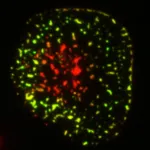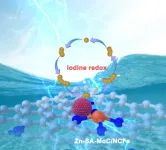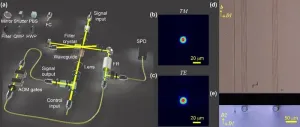(Press-News.org) Since its discovery in the 1990s, “programmed cell death protein 1,” or PD-1, has been regarded as a leading target in cancer treatments. A “checkpoint” receptor that often resides on the surface of immune system cells, the PD-1 molecule works as a type of off switch that keeps immune cells from attacking other cells.
After its discovery, which revolutionized oncology and earned a 2018 Nobel Prize, researchers developed new drugs to block PD-1 and unleash the body’s immune system to fight cancer. Yet treatments leveraging PD-1 are only effective in a small fraction of cancer patients, highlighting the need for a deeper understanding of how PD-1 works. Much of our current knowledge of PD-1’s functions comes from studies in mice, grounded on the assumption that rodent and human biology operate similarly.
Researchers in UC San Diego’s School of Biological Sciences and School of Medicine have now discovered that this assumption may be flawed. In a comprehensive assessment of PD-1 that featured novel biochemical analyses, animal modeling and a new evolutionary roadmap tracing PD-1 back millions of years, the UC San Diego scientists and their colleagues at the Chinese Academy of Sciences found that PD-1 in mice is significantly weaker than the human version.
The study, led by assistant project scientist Takeya Masubuchi, revealed several previously unknown PD-1 characteristics, including a “motif” — a specific sequence of amino acids — that is vastly different in rodents and humans.
“Our work uncovers unexpected species-specific features of PD-1 with implications for developing better pre-clinical models for PD-1,” said Associate Professor Enfu Hui of the School of Biological Sciences, Department of Cell and Developmental Biology, and a senior author of the paper. “We found a motif in PD-1 that’s present in most mammals, including humans, but is surprisingly missing in rodents, making rodent PD-1 uniquely weaker.”
The results of the study are published January 3, 2025, in the journal Science Immunology.
“Although many proteins in mice and humans have similar sequences, receptors in the immune system often show greater differences,” said Masubuchi. “Our study shows that these sequence differences can lead to functional variations of immune checkpoint receptors across species.”
Furthering their analysis, the researchers tested the impact of PD-1 humanization in mice — replacing mouse PD-1 with the human version — through co-senior author Professor Jack Bui’s laboratory in the Department of Pathology. They found that PD-1 humanization disrupted the ability of immune cells (T cells) to combat tumors.
“This study shows that as science progresses we need to have a rigorous understanding of the model systems that we use to develop medicines and drugs,” said Bui. “Finding that rodents might be outliers in terms of PD-1 activity forces us to rethink how to deploy medicines to people. If we’ve been testing medicines in rodents and they’re really outliers, we might need better model systems.”
To trace the PD-1 human-rodent differences over time, the researchers collaborated with co-senior author Professor Zhengting Zou and his Chinese Academy of Sciences colleagues. They discovered evidence of a major dip in ancestral rodent PD-1 activity around 66 million years ago after the Cretaceous–Paleogene (K–Pg) mass extinction event, which wiped out the (non-avian) dinosaurs. The analysis showed that the rodent PD-1 is uniquely weak among all vertebrates. The weakening may be attributed to special ecological adaptations to escape the effects of rodent-specific pathogens.
“The rodent ancestors survived the extinction event but their immune receptor activities or landscape might have been altered as a consequence of adaptation to new environmental challenges,” said Hui.
Future studies will assess the impact of PD-1 on the anti-tumor activity of T cells in a humanized context across various tumor types.
END
Scientists unveil surprising human vs mouse differences in a major cancer immunotherapy target
Results of a comprehensive analysis refute assumptions that a key immune checkpoint receptor functions the same in rodents and humans
2025-01-03
ELSE PRESS RELEASES FROM THIS DATE:
NASA’s LEXI will provide X-ray vision of Earth’s magnetosphere
2025-01-03
A NASA X-ray imager is heading to the Moon as part of NASA's Artemis campaign, where it will capture the first global images of the magnetic field that shields Earth from solar radiation.
The Lunar Environment Heliospheric X-ray Imager, or LEXI, instrument is one of 10 payloads aboard the next lunar delivery through NASA’s CLPS (Commercial Lunar Payload Services) initiative, set to launch from the agency's Kennedy Space Center in Florida no earlier than mid-January, with Firefly Aerospace’s Blue Ghost Lander. The instrument will support ...
A successful catalyst design for advanced zinc-iodine batteries
2025-01-03
Aqueous zinc-ion batteries (ZIBs) have attracted extensive attention due to their high safety, abundant reserves, and environmental friendliness. Iodine with high abundance in seawater (55 μg L−1) is highly promising to fabricate zinc-iodine batteries due to high theoretical capacity (211 mAh g−1) and appropriate redox potential (0.54 V). However, the low electrical conductivity of iodine hinders the redox conversion for the efficient energy storage process with zinc. Additionally, the formed soluble polyiodides are prone to migirate to Zn anode, leading to capacity degration and ...
AMS Science Preview: Tall hurricanes, snow and wildfire
2025-01-03
The American Meteorological Society continuously publishes research on climate, weather, and water in its 12 journals. Many of these articles are available for early online access–they are peer-reviewed, but not yet in their final published form.
Below is a selection of articles published early online recently. Some articles are open-access; to view others, members of the media can contact kpflaumer@ametsoc.org for press login credentials.
JOURNAL ARTICLES
The Impact of Snowoff Timing and Associated Atmospheric Drivers on the Alaska Wildfire Season
Earth Interactions
Earlier ...
Study finds 25% of youth experienced homelessness in Denver in 2021, significantly higher than known counts
2025-01-03
AURORA, Colo. (Jan. 3, 2025) – A first of its kind study, published today in Pediatrics, has provided full-picture assessment of youth homelessness in Denver, Colorado. The findings reveal that nearly 25% of youth in Denver experienced homelessness or housing insecurity in 2021, with rates increasing almost every year since 2017.
Researchers across Colorado, led by Josh Barocas, MD and resident Matthew Westfall, MD of the University of Colorado Anschutz Medical Campus, combined multiple data sources for youth aged 14 to 17 in the City of Denver, to estimate the total number ...
Integrated spin-wave quantum memory
2025-01-03
The synchronization function of quantum memories can be employed to connect multiple short-distance entanglement into long-distance entanglement, so that to effectively overcome the transmission loss of photons and enable the construction of large-scale quantum networks. The rare-earth ions doped crystals is a candidate system for implementation of quantum memories with excellent performances, and integrated solid-state quantum memories have been successfully demonstrated with various micro- and nano- fabrication techniques.
All previous demonstrations of integrated quantum memories for light are limited to the storage ...
Brain study challenges long-held views about Parkinson's movement disorders
2025-01-03
University of Arizona researchers have revealed new insights into one of the most common complications faced by Parkinson's disease patients: uncontrollable movements that develop after years of treatment.
Parkinson's disease – a neurological disorder of the brain that affects a person's movement – develops when the level of dopamine, a chemical in the brain that's responsible for bodily movements, begins to dwindle. To counter the loss of dopamine, a drug called levodopa is administered and later gets converted into dopamine in the brain. However, long-term treatment with levodopa induces ...
Mental disorders among offspring prenatally exposed to systemic glucocorticoids
2025-01-03
About The Study: In this cohort study, prenatal exposure to glucocorticoids was associated with higher risk of some mental disorders. These data support continued caution in the use of glucocorticoids in pregnant people.
Corresponding Author: To contact the corresponding author, Kristina Laugesen, PhD, email kristina.laugesen@clin.au.dk.
To access the embargoed study: Visit our For The Media website at this link https://media.jamanetwork.com/
(doi:10.1001/jamanetworkopen.2024.53245)
Editor’s Note: Please see the article for additional information, including other authors, author contributions ...
Trends in screening for social risk in physician practices
2025-01-03
About The Study: In this survey-based cross-sectional study of U.S. physician practices, social risk screening increased substantially from 2017 to 2022, although still less than one-third of practices systematically screened for a set of 5 common social risks (food, housing, utilities, interpersonal violence, and transportation). What remains to be seen is whether practices use these data to help improve patient health by adjusting health care or referring patients for assistance with social needs. As policies and incentives increasingly emphasize social risk screening, it will be important to assess the association of screening and referrals with patient ...
Exposure to school racial segregation and late-life cognitive outcomes
2025-01-03
About The Study: This cross-sectional study of Black and white older individuals found that childhood exposure to school segregation was associated with late-life cognition among the Black population. Given the increasing amount of school segregation in the U.S., educational policies aimed at reducing segregation are needed to address health inequities. Clinicians may leverage patients’ early-life educational circumstances to promote screening, prevention, and management of cognitive disorders.
Corresponding Author: To contact the corresponding author, Xi Chen, PhD, email xi.chen@yale.edu.
To ...
AI system helps doctors identify patients at risk for suicide
2025-01-03
A new study from Vanderbilt University Medical Center shows that clinical alerts driven by artificial intelligence (AI) can help doctors identify patients at risk for suicide, potentially improving prevention efforts in routine medical settings.
A team led by Colin Walsh, MD, MA, associate professor of Biomedical Informatics, Medicine and Psychiatry, tested whether their AI system, called the Vanderbilt Suicide Attempt and Ideation Likelihood model (VSAIL), could effectively prompt doctors in three neurology clinics at VUMC to screen patients for suicide risk during regular clinic visits.
The study, reported in JAMA Network Open, compared two approaches — automatic ...
LAST 30 PRESS RELEASES:
Sports injuries sustained during your period might be more severe
World's first successful 2 Tbit/s free-space optical communication using small optical terminals mountable on satellites and HAPS
Can intimate relationships affect your heart? New study says ‘yes’
Scalable and healable gradient textiles for multi‑scenario radiative cooling via bicomponent blow spinning
Research shows informed traders never let a good climate crisis go to waste
Intelligent XGBoost framework enhances asphalt pavement skid resistance assessment
Dual-function biomaterials for postoperative osteosarcoma: Tumor suppression and bone regeneration
New framework reveals where transport emissions concentrate in Singapore
NTP-enhanced lattice oxygen activation in Ce-Co catalysts for low-temperature soot combustion
Synergistic interface engineering in Cu-Zn-Ce catalysts for efficient CO2 hydrogenation to methanol
COVID-19 leaves a lasting mark on the human brain
Scientists use ultrasound to soften and treat cancer tumors without damaging healthy tissue
Community swimming program for Black youth boosts skills, sense of belonging, study finds
Specific depressive symptoms in midlife linked to increased dementia risk
An ‘illuminating’ design sheds light on cholesterol
Who is more likely to get long COVID?
Study showcases resilience and rapid growth of “living rocks”
Naval Research Lab diver earns Office of Naval Research 2025 Sailor of the Year
New Mayo-led study establishes practical definition for rapidly progressive dementia
Fossil fuel industry’s “climate false solutions” reinforce its power and aggravate environmental injustice
Researchers reveal bias in a widely used measure of algorithm performance
Alcohol causes cancer. A study from IOCB Prague confirms damage to DNA and shows how cells defend against it
Hidden viruses in wastewater treatment may shape public health risks, study finds
Unlock the power of nature: how biomass can transform climate mitigation
Biochar reshapes hidden soil microbes that capture carbon dioxide in farmland
Reducing saturated fat intake shows mortality benefit, but only in high-risk individuals
Manta rays create mobile ecosystems, study finds
Study: Mixed results in using lipoic acid to treat progressive multiple sclerosis
Norbert Holtkamp appointed director of Fermi National Accelerator Laboratory
New agentic AI platform accelerates advanced optics design
[Press-News.org] Scientists unveil surprising human vs mouse differences in a major cancer immunotherapy targetResults of a comprehensive analysis refute assumptions that a key immune checkpoint receptor functions the same in rodents and humans





